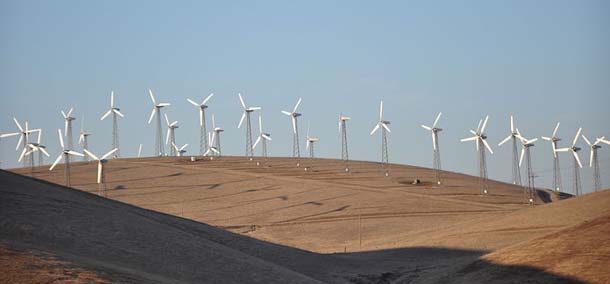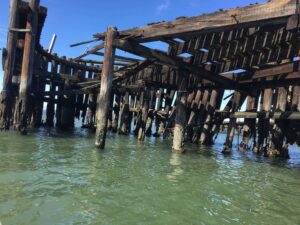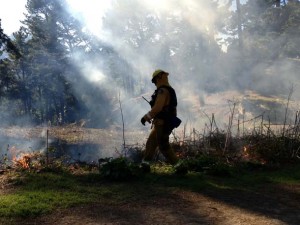Wind power companies are taking a bird’s eye view in siting new turbines in the Altamont Pass.
As a major re-powering effort gets underway to replace 50-year-old windmills with fewer and larger ones, the companies are making use of new techniques in risk mapping to avoid the numbers of raptor deaths that have become part of the political fabric of the Altamont Wind Resource Area.
Using observations of raptor flight behavior, the 3-D risk maps show color-coded hazard zones that predict where siting a wind turbine would be especially dangerous to a soaring bird. Site that same turbine a mere 10 feet away and bird deaths could dramatically drop, said Doug Bell, the wildlife program manager for the East Bay Regional Park District.
“Raptors don’t use airspace randomly,” said Bell, who oversaw the making of the risk map project. “Not all airspace is created equal in their eyes.”
The Altamont Pass is a mountain pass east of Livermore that’s the location of one of the oldest and largest wind farms in the country. It’s also a way-station for migrating raptors, which make use of healthy range-lands, good weather, and strong winds for hunting. The area has one of the densest populations of nesting golden eagles in the world.
But wind turbines and raptors are a lethal combination. Every year, an estimated 2,000 raptors meet their fate in the whipping blades, along with as many as 8,000 other birds and bats. A spate of lawsuits brought on by environmentalists has forced the wind companies to rethink how they’re running their operations. The main response has been to change out the old turbines with newer ones that are taller, larger, and less likely to imperil birds. That’s where the risk maps come in.
Better understood raptors
The project dates back to a 2006 study of raptors led by ecologist Shawn Smallwood at Vasco Caves Regional Preserve in the Altamont. The study looked at whether raptors would leave the area if the vegetation surrounding the turbines became less habitable to prey species. The results from that study were inconclusive, but they teased out an interesting trend: given the choice, raptors preferred to forage in turbine-free hills. The scientists starting thinking about how to use topography as a way to better understand raptor behavior.
In the follow-up study at Vasco Caves, they recorded 774 hours of observations of flight
patterns in four key indicator species: golden eagles, red-tailed hawks, American kestrels, and burrowing owls. They found that some flight behaviors — like hovering and kiting — are far riskier than others. American kestrels spend a lot of time hovering, and they can easily cruise backward into wind turbines.
Location matters, too. Red-tailed hawks seem to really like hovering over the windward side of southwest slopes. Those winds provide a good lift so they can soar with minimal effort.
“They’re lazy. They economize,” said Bell. “What this tells you is if you’re trying to site a wind farm you wouldn’t want to put the turbines on the windward side [or the ridge line] because that’s where you’re going to have the most frequent red-tailed hawk flights and you’ll chop them up.”
The risk maps function as a digital elevation model of the landscape. Different features, such as elevation, slope, and even the quality of foraging habitat are stacked across a grid with the observation data showing the locations of the birds. You can then pluck out the features that best explain why you see, say, golden eagles, in a particular spot. Golden eagles are particularly oblivious to the dangers of wind turbines.
“They’re the top dog and they go wherever they want to, whenever they want to,” said Bell. “So they are the ones least cognizant of turbines. It’s like it’s not even in their realm because they’re the top predator.”
Money matters
Of course, turbine sitings matter to wind companies, too. Often the best spots for wind power generation are the same spots that are most dangerous to raptors. Two major windpower companies in the Altamont — Pattern Energy and NextEra Energy — are in the middle of massive repowering projects right now, a result of a series of settlements with environmental groups to reduce bird deaths and replace the most dangerous turbines.
Neither company would comment on this story. But Michael Lynes, general counsel for Golden Gate Audubon Society and party to the lawsuits, said the wind companies were legally forced to do something about the bird deaths, and the economics of re-powering made sense, too.
“The old turbines were not efficient and were breaking down. They were starting to see the end of life of the old turbines, so it’s a good time to re-power,” Lynes said. “Also, there were tax incentives and stimulus money that made it attractive and they didn’t want to deal with the old settlement.”
There are some limitations to using the risk maps. The big one is that it’s predictive and not certain. Once a turbine goes up, it’s up, even if it turns out to be a danger to birds. Also, the new turbines are taller and have larger blades, not exactly an apples-to-apples comparison with the ones that were part of the risk map project.
Still, the risk maps are better than nothing, said Lynes.
“I don’t want to be giddy but it’s definitely a big improvement over what has been done in the past without any environmental review at all,” he said.
Bell said new raptor studies are also getting more precise. Scientists are starting a new one that will tag golden eagles in the Altamont with satellite transmitters that will record movement patterns every 30 seconds.
“We’re desperate to get that done as soon as possible because there are going to be more and more re-powering phases,” said Bell. “Wind companies are very pleased with this information because it helps them justify their turbines and their sitings.”

.jpg)




